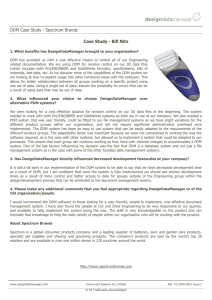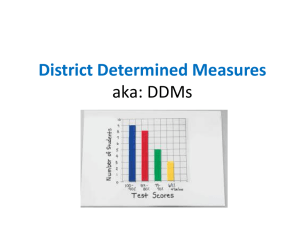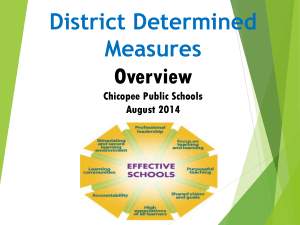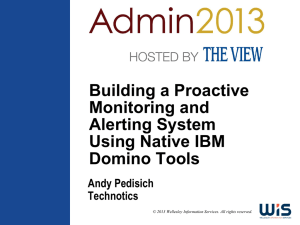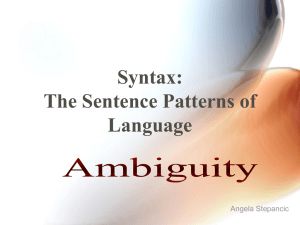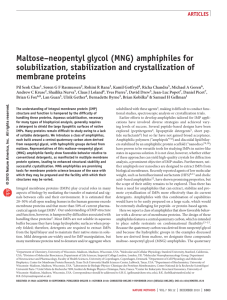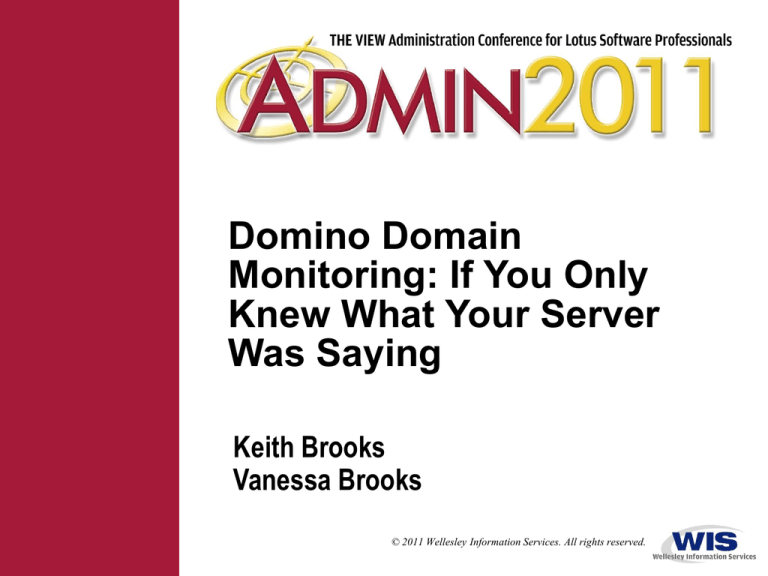
Domino Domain
Monitoring: If You Only
Knew What Your Server
Was Saying
Keith Brooks
Vanessa Brooks
© 2011 Wellesley Information Services. All rights reserved.
In This Session ...
Today’s Simple (?!) Goal:
How to improve your Lotus infrastructure
(or at least be more pro-active about it)
using DDM
1
What We’ll Cover …
•
•
•
•
•
Introduction and background of DDM
Understanding ambiguous messages
Managing the ambiguous messages
Performing some DDM editing and customization on a server
Wrap-up
2
Introduction
•
Does this sound familiar?
Your server is crying out in pain and you don’t hear it, or worse,
ignore it … at your peril.
Daily, hourly it suffers in silence because you do not let it talk
to you.
You know it can talk, right?
Then you turn it on and it talks, non-stop!
So you shut it off again.
3
Background of DDM
•
•
•
•
•
•
Started with R7 although its history goes back to Stats and Events
DDM (ddm.nsf) is a reporting database
It reports based on details that the Monitoring
Configuration (events4.nsf) database has defined
Events (events4.nsf) is the real information
wrapped around by the ddm.nsf
It is installed with every copy of Domino yet many
never use it … why?
If you use it, you probably set it up once and
never looked at it again ... right?
4
Best Practice (From LS10 Paul Mooney’s Session)
•
Tip #57: Domino Domain monitor keeps you safe
Enable DDM
Have DDM tell you when anonymous gets added to a
database over a certain level
Have DDM tell you not only that there is a problem, but
suggests how to fix it!
Have DDM bring you directly to the problem
Monitoring software makes your life easier
5
DDM — Making Everyone Accountable
•
Inside DDM you can:
See everything is right or wrong
See who closed which items at issue
Delegate problems to someone else
Provide management with a dashboard
Change severity of error messages
Monitor ACLs, security, SMTP, and on and on as long as it’s a
Domino item*
•
* There are ways to do this for non-Domino, but not by default
6
DDM — What Does It Look Like? Brief Demo.
7
What We’ll Cover …
•
•
•
•
•
Introduction and background of DDM
Understanding ambiguous messages
Managing the ambiguous messages
Performing some DDM editing and customization on a server
Wrap-up
8
Questionable Severity
Access to server VIEW/DEMO is slow. [KBRS-7UQLW]
Originating Server: VIEW/DEMO
Event Severity: Failure
Event Type: Server
Event Time: 08/16/2010 07:54:17 PM
To see the document that triggered this notification,
click here Notes Link
Bit extreme, probably should
be a Warning High/Low
9
Knowledge a PHB* Would Require
Access to server VIEW/DEMO has been
reestablished., [KBRS-87UQLW]
Originating Server: VIEW/DEMO
Event Severity: Normal
Event Type: Server
Event Time: 08/16/2010 08:09:06 PM
Very nice, but
why do we get
this if we didn’t
ask for it?
To see the document that triggered this notification,
click here Notes Link
•
Why do we want to know this at all?
*Pointy Haired Boss
10
Attack of the Ambiguous Error Message
•
•
•
•
•
•
•
•
•
Cannot process Full Text Index (FTI)
Admin Process: Gone Fishing/Org does not appear in design
elements of any database designating Server/Demo as their
Administration Server
SMTP Failed to Connect to us.ibm.com
Gone Fishing/Org attempted to login to Server/Demo
SSL Error: Keyring File access error
Unable to replicate or route mail
Calendar profile error
Events database missing documents or duplicated
Unable to compact compact no such file exists (program doc
added compact twice)
11
Attack of the Ambiguous Error Message — Troubleshooting
•
So now what? The great DOMINO has spoken, you must resolve
the problem, but how?
DDM does not always provide any details
Check your server console
The answer may be staring you in the face, if not, search
your log.nsf file for the text of the error
Check that you are running enough debug level in your log to
show these errors
Dig deeper within the system from the Administrator monitoring
and analysis tools to the new DCT
Google, Planetlotus.org, Bloggers, IBM Support
12
What DDM Sends You via Email
•
An email with a subject heading:
Admin Process: Completed maintenance of mailfiles for 0
databases, 0 databases reported errors.
•
And in the body this:
Originating Server: Domino/DEMO
Event Severity: Warning (high)
Event Type: Misc
Event Time: 08/18/2010 01:00:52 PM
This should be a Failure or
a Normal, don’t you think?
To see additional information about this error
message, click here -->
(Document link: Error Message Document)
Do these links
To see the document that triggered this help?
notification, click here -->
(Document link: Event Notification Document)
13
What Those Links Reveal
•
•
The Events4.nsf database when you follow the links
And quite possibly ends up looking like this: Blank
14
So Now What Do You Do?
•
If you are shown a blank page, you still have to troubleshoot the
problem
•
BUT
•
Did you know you can enter your text/data for next time as well?
15
What We’ll Cover …
•
•
•
•
•
Introduction and background of DDM
Understanding ambiguous messages
Managing the ambiguous messages
Performing some DDM editing and customization on a server
Wrap-up
16
How to Create an Event Report and Cause
•
•
•
•
Open events4.nsf, go to Advanced, Event Messages by Text and
enter something
However, the most common way now affects only R7 and earlier
servers
The new R8 way requires one to produce Modular Documents
So where do we find these Modular Documents?
17
Creating a Modular Document Part A
•
Open the events4.nsf database to find:
•
Clicking on this will show a list that has three subheadings as well
as numerous documents:
18
Creating a New Modular Document Part B
•
•
Clicking on the New Modular Document button, you will be asked
to select the purpose of your input
Probable Cause Text and Probable Solution Text have the text
line, as shown, which will then be available for any future events
19
Creating a New Modular Document Part C
•
What if you want automatic corrective action using formulas or
LotusScript? Add them in the fields.
•
Note: Check Syntax is for Formulas only
20
Creating a New Modular Document Part D
•
Using an Agent to correct something may be helpful as well and
the options are database-specific
21
If You Did It Right
•
You would enter this in the field:
22
And Find This in the List
•
Now go look at the options for you to choose from and you will
find this:
23
Future Information Domino Will Provide
•
•
Make it fun if you want ... but to the point
Sometimes there is no why!
But there is a solution!
24
Understanding where DDM Messages Originate
An example using Mail Statistics, below is from a standalone
server
The probe has failed for the following statistic: QOS.Mail.local
server self probe.ResponseTime [srvr-##L#L#]
•
Originating Server: Srvr1/TheView
Event Severity: Warning (high)
Event Type: Mail
Event Time: 08/10/2010 10:29:56 PM
To see additional information about this error message, click here
Notes Link
To see the document that triggered this notification, click here
Notes Link
25
Additional Information Link Shows — Lotus Entries
•
Nothing under Lotus Entries
26
Additional Information Link Shows — Custom Entries
•
So the additional information may not help or be what you are
seeking every time
27
Document That Triggered This Notification
•
Still no details found beyond that the item is part of an event
notifier
So Where Did It Come From?
1.
2.
3.
4.
Open the events4.nsf database
Locate the Event Generators Section
Based on the item, find it in the list
In this case, it is under Mail Routing
29
The Routing Event, Found at Last
•
Opening up the entry below shows the details for the probe and
its timing
•
Edit it as you see fit
30
You Can Handle the Truth
•
•
•
There are many ways to receive notifications
But what do you do when the problem is in your MAIL server
which prevents email from flowing?
Go to Ideajam.net and vote for it to add Twitter or whatever you
think is best!
http://ideajam.net/IdeaJam/P/ij.nsf/0/C002DE309231F71B862577
830058A332?OpenDocument
31
What We’ll Cover …
•
•
•
•
•
Introduction and background of DDM
Understanding ambiguous messages
Managing the ambiguous messages
Performing some DDM editing and customization on a server
Wrap-up
32
Demo
•
Demo Live what we just walked through
www.addletters.com/pictures/bart-simpson-generator/953806.htm
33
What We’ll Cover …
•
•
•
•
•
Introduction and background of DDM
Understanding ambiguous messages
Managing the ambiguous messages
Performing some DDM editing and customization on a server
Wrap-up
34
Mission: Understand Domino Domain Monitor (DDM)
Today’s Simple (?!) Goal:
How to improve your Lotus infrastructure
(or at least be more pro-active about it)
using DDM
35
Resources
•
•
•
•
Planetlotus.org – 315+ Lotus Bloggers especially, Andy Pedisich who
gives a much more detailed session on DDM
IBM Infocenter
http://publib.boulder.ibm.com/infocenter/domhelp/v8r0/index.jsp?topi
c=/com.ibm.help.domino.admin85.doc/H_DOMINO_DOMAIN_MONITO
RING_DDM_OVER.html
• Philip Monson, Thomas Gumz, Frank Nostrame, Leah Busque, “Lotus
Domino Domain Monitoring” (IBM Redbook, 2005).
DDM Redpiece(R7) Part# REDP-4089-00
www.redbooks.ibm.com/abstracts/redp4089.html
Domino Wiki Site for DDM:
www.lotus.com/ldd/dominowiki.nsf/dx/domino-domain-monitoring
Marc Champoux Blog Post on Monitoring non-Lotus Tasks:
www.thenewdominoadmin.com/blog/?p=397
36
7 Key Points to Take Home
•
•
•
•
•
•
•
DDM is free and running ... use it
You decide what to monitor and you should be monitoring
Be Proactive, not Reactive
Edit common issues that are unique to your organization or
without details in DDM so the next admin has it easier
Careful not to flood your inbox with warnings
Management can have a dashboard with colors, give it to them
Ambiguous error messages are a thing of the past, if you take the
initiative
37
Your Turn!
How to contact me:
Keith Brooks
keith@vanessabrooks.com
38

